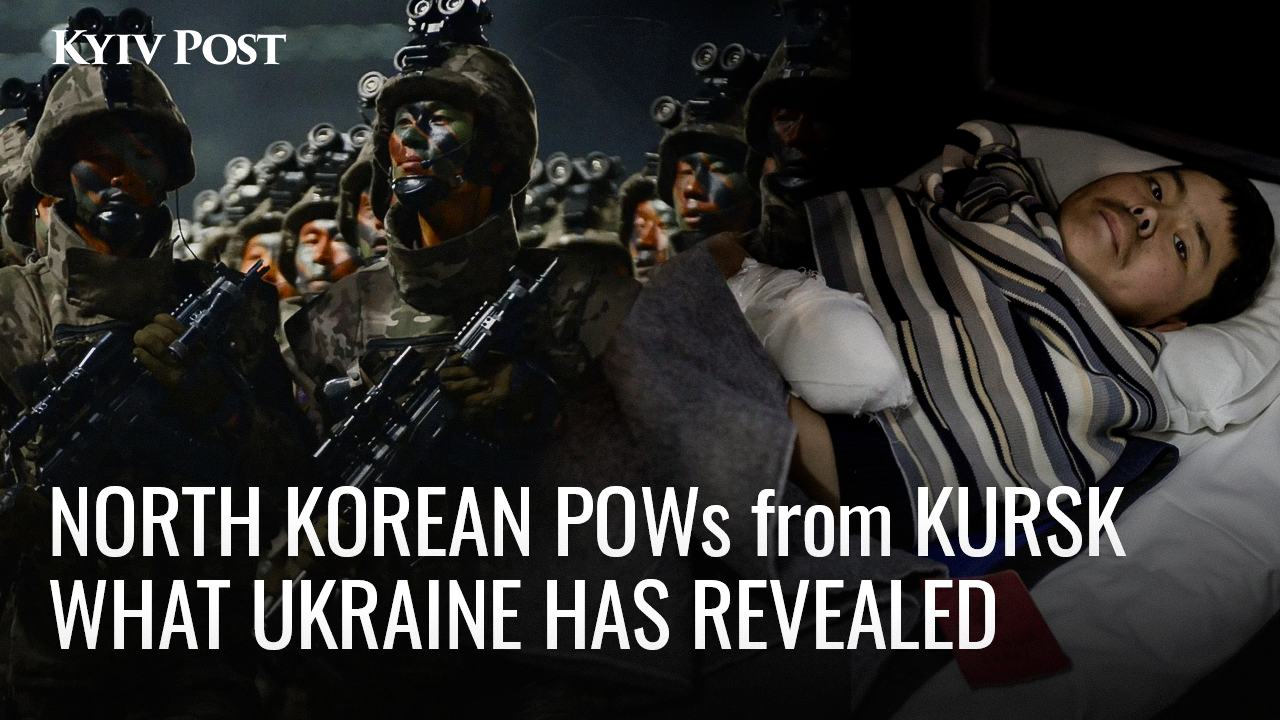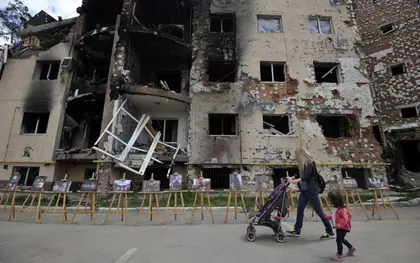Feb. 24, 2022: Russia launches its full-scale invasion of Ukraine
Described as the largest ground-and-air attack on a European country and the first full-scale war in Europe since World War II, Moscow begins the day with air strikes on the capital Kyiv, the Black Sea port Odesa, and the country’s second-largest city, Kharkiv, near the border with Russia, as well as other important sites.
JOIN US ON TELEGRAM
Follow our coverage of the war on the @Kyivpost_official.
Putin announces he intends to demilitarize and “de-Nazify” Ukraine, marking the beginning of Kremlin propagandists’ efforts to frame their invasion of a sovereign country as a sort of defense against a fascist regime: a very deep-seated emotional appeal to the older generation of Russians especially, born in the Soviet Union, which lost 27 million people in World War II fighting Hitler (a disproportionate amount of them Ukrainian).
Feb. 25, 2022: Battle of Kyiv begins in earnest
At about the same time as they initially launched air strikes across the country, Moscow’s forces engaged Ukrainian troops at and around Hostomel Airport, just outside the capital, and captured the airport’s surrounding district on Feb. 25.
That day, three Russian saboteurs disguised as Ukrainian soldiers entered the northern Obolon neighborhood but were soon killed by Armed Forces of Ukraine (AFU) soldiers. Several hours later, a Ukrainian Sukhoi Su-27 fighter aircraft was shot down over Kyiv and crashed into an apartment building.

‘A Holiday is a Holiday, No Matter the Faith’ – Some Ukrainians Mark Epiphany in Russian-linked Churches
Heavy gunfire was heard all night in Kyiv, and the AFU claimed to have killed about 60 Russian saboteurs in those initial attacks on the capital. Ultimately, Kyiv was completely liberated by the beginning of April, despite the Kremlin’s proclamation that it successfully would take the Ukrainian capital in just a few days.
February-March 2022: Bucha massacre
On Feb. 27, 2022, as part of the siege on the area around the capital, invading forces moved into the city of Bucha, making it one of the first outlying areas of Kyiv conquered by Moscow. Russian soldiers went on to massacre the town’s civilians and hold them hostage in basements as their family members and neighbors died and decomposed in houses-turned-prisons.
Bucha’s mayor, Anatoliy Fedoruk, on March 7, told reporters that “we can’t even gather up the bodies because the shelling from heavy weapons doesn’t stop day or night. Dogs are pulling apart the bodies on the city streets… Here in Bucha, we see all the horrors we heard about as crimes committed by the Nazis during the Second World War.”
The UN High Commission for Human Rights estimates that between 73 and 138 Ukrainian civilians were murdered during the Russian siege of Bucha.
This is shocking, footage from #Bucha that shows #Russian invaders firing on the civilians from the tanks and killing them in the streets. #Russia can't cover up and whitewash #BuchaMassacre pic.twitter.com/cMqjSOew6q
— Giorgi Revishvili (@revishvilig) April 5, 2022
April 14, 2022: Sinking of the Moskva
The flagship of the Russian Navy’s Black Sea Fleet, named after the Russian capital, was sunk by the AFU’s Neptune missiles on April 14. Ukrainian officials announced that their forces had fatally damaged the Moskva with two anti-ship missiles, and that it had then caught fire. The fire reached the munitions storage, which subsequently exploded. The Pentagon later confirmed this, while Moscow reported that the ship had “sunk in stormy seas.”
It was the largest Russian warship to be sunk in wartime since the end of World War II, and the first Russian flagship sunk since the Knyaz Suvorov in 1905 during its war with Japan.
Moscow’s Ministry of Defense said that there were 27 sailors missing, but there were unconfirmed reports of more casualties. At least 17 of the missing crew members were later declared dead by a court in Russian-occupied Sevastopol.
🔥🔥
— Азов South (@Azovsouth) April 14, 2024
14 April 22
The first footage appeared on the network showing Russia's and Putin' pride (Black Sea Fleet flagship #Moskva sinking).
This one was hit by 🇺🇦Ukrainian made R-360 Neptune subsonic anti-ship cruise missile with all-weather capabilities. pic.twitter.com/Z0C1XLeJs7
Feb. 24 – May 20, 2022: Siege of Mariupol
The International Red Cross described the Russian siege of Mariupol and its signature steel plant as “apocalyptic.” The international community accused Moscow of intentionally creating a major humanitarian crisis there, with the UN reporting that at least 1,348 civilians had been killed but warning that the actual number could be thousands more. At least 95 percent of the city had been destroyed by Russian bombing.
Russian attacks began in earnest in the first few days of March, but by April 2022, the well-defended Azovstal iron and steel works became the besieged headquarters of the resistance there, in the heart of the otherwise occupied Donetsk city, described as a “fortress” that was difficult to occupy by Russian aerial bombardments. The plant had tunnels and bunkers capable of withstanding a nuclear attack.
A 2023 documentary entitled “20 Days in Mariupol” followed a team of Ukrainian journalists “trapped in the besieged city of Mariupol struggle to continue their work documenting atrocities of the Russian invasion. As the only international reporters who remained in the city, they captured what would later become defining images of the war: dying children, mass graves, the bombing of a maternity hospital, and the pervasive fear of aerial bombardment.
The AFU surrendered the Azovstal plant on May 20.
Nov. 11, 2022: AFU completes liberation of Dnipro’s right bank
After nearly nine months of Russian occupation, the right bank of the Dnipro River, including the city of Kherson and large parts of the Mykolaiv region, was liberated by defense forces as Moscow’s troops withdrew to the eastern side of the river. Incoming AFU tanks were greeted by flag-waving crowds as they moved into the city’s downtown, and Russian soldiers crossed a pontoon bridge in what was described as a chaotic retreat.
Later, Ukrainian platoons would carry out daring crossings of the river to set up defenses on the left bank but ultimately were unsuccessful in pushing Russian forces further east.
May 20, 2023: Fall of Bakhmut
The Battle of Bakhmut was one the bloodiest fights in the war, with an estimated 20,000 Russian troops killed over 10 months, mostly from the mercenary Wagner group. Some 200 civilians were killed over that time frame. The battle drew comparisons to the siege of Stalingrad in World War II for its intensity and high rates of attrition.
By May 20, 2023, Moscow’s forces had taken over all but a small strip of land along one of the highways out of town.
Sept. 13, 2023: Ukrainian bombs and missiles sink three Russian naval vessels within a single day
Storm Shadow missiles fired from Ukrainian Su-24 bombers destroyed two Russian naval assets in the Sevastopol shipyard on Sept. 13, 2023: the Minsk landing ship and a Kilo-class submarine, the Rostov-on-Don.
The next day, a Ukrainian naval drone severely damaged a brand-new Project 22160 patrol ship, the Sergey Kotov. It was repaired, but five months later it was again attacked by the AFU’s surface UAVs and this time sunk.
By November of 2024, official Ukrainian figures for destroyed Russian ships during the war stood at 28.
The Ukrainians had effectively expelled the Russian Navy from Crimea with scarcely a navy of its own to speak of.
⚡️🇷🇺Russian Landing ship "Minsk" after a missile attack up close pic.twitter.com/ed9eSGzv2g
— 🪖MilitaryNewsUA🇺🇦 (@front_ukrainian) September 14, 2023
Oct. 10, 2023: Moscow begins major offensive in AFU stronghold of Avdiivka
Like Bakhmut, the battle of Avdiivka was one of the costliest in terms of human lives, and strategically even more significant as the industrial city was a key transportation hub and an important AFU bulwark in the Donetsk region.
Although there had been intermittent fighting there since 2014, it was on Oct. 10, 2023, that Russia launched a major offensive that began a brutal four-month struggle for control of the city’s coke plant and its highways in and out of the town. Kyiv estimated that some 17,000 Russian soldiers were killed, as were 154 civilians. Two schools were destroyed by white phosphorus munitions.
The last Ukrainian defenders ultimately withdrew from their positions on Feb. 17, 2024.
April 20, 2024: US approves $61B in military aid for Ukraine after months of stalling
After approximately four months of stonewalling by Republicans in the House of Representatives, US Congress finally passed a bill for Ukraine aid, amounting to about $61 billion to replace donated American weapons from stockpiles, plus other equipment and funding. In the lost time, Ukraine’s counteroffensive that it had launched the previous summer had slowed down due in part to dwindling ammunition.
The US has thus far sent Ukraine roughly $111 billion in weapons, equipment, humanitarian assistance, and other aid since the start of the war, with European countries contributing roughly the same through various initiatives. After the Nov. 5 election of Donald Trump for president, which also saw Republicans take complete control of the legislature, Kyiv and Western leaders have not been optimistic that US funding of Ukraine’s defense will continue in any significant way.
July 8, 2024: Russian airstrike hits children’s hospital in Kyiv
As part of a barrage that targeted cities across Ukraine and killed at least 42 civilians, including five children, Russian forces launched cruise missiles at the Ohmatdyt Children’s Hospital in Kyiv. The toxicology wing collapsed, damaging large portions of surrounding buildings that housed several different medical departments. In all, more than 190 people were injured in the attack.
As of June of 2024, the UN Human Rights Monitoring Mission in Ukraine estimated the number of civilians killed since the start of the full-scale invasion at least 9,560 civilians, plus at least 21,450 injured, mainly by explosive weapons with wide area effects. The death toll included 594 children.
Aug. 6, 2024: Ukraine launches incursion into Kursk
At least 1,000 AFU troops crossed over the border with Russia’s Kursk region on Aug. 6, 2024, in a column of tanks and armored vehicles. In just a week, Ukrainian forces controlled about 400 square miles of Russian territory.
Coinciding with its incursion, Ukraine has carried out numerous successful drone attacks deep into Russia, destroying ammunition depots, fuel storages, airfields and other energy and military infrastructure across the country.
You can also highlight the text and press Ctrl + Enter













